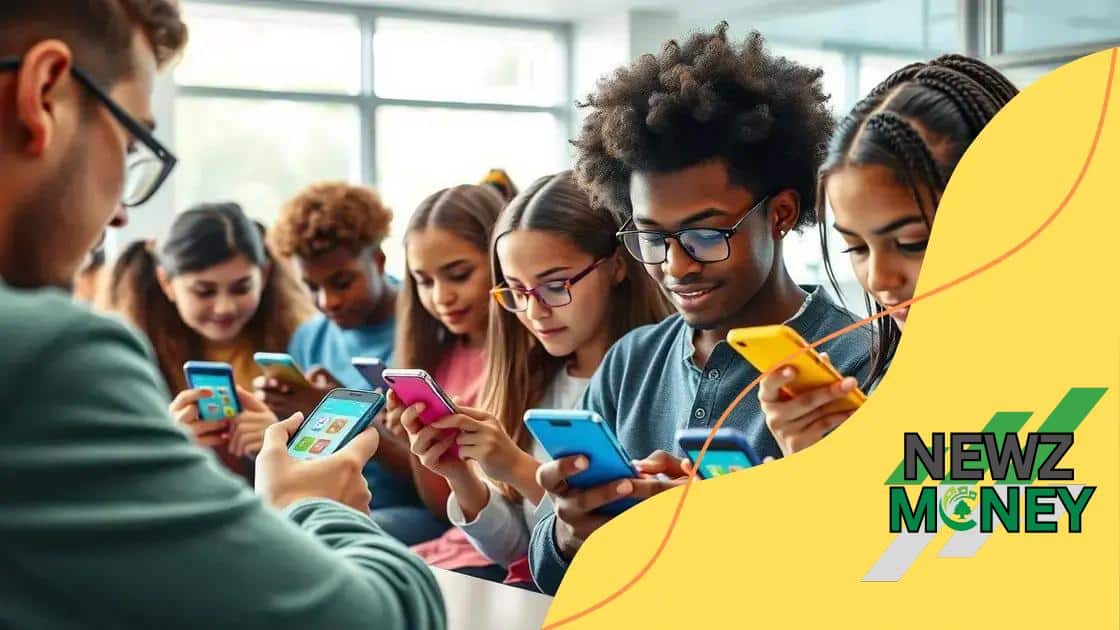Mobile learning apps for remote and on-the-go education

Mobile learning apps for remote and on-the-go education leverage features like AI, AR/VR, and gamification to enhance personalized and engaging learning experiences anytime and anywhere.
Mobile learning apps for remote and on-the-go education are transforming how we learn in today’s fast-paced world. Imagine having the ability to study anytime, anywhere. This convenience opens up a world of possibilities for continuous education.
Understanding mobile learning applications
Understanding mobile learning applications can greatly enhance your educational experience. These apps are designed to provide learning opportunities anytime and anywhere. With the rise of technology, traditional learning methods are evolving, and mobile applications play a crucial role in this transition.
Features of Mobile Learning Apps
Mobile learning applications come with several features that facilitate effective learning. Users can engage with content through:
- Interactive tools: These apps often include quizzes and interactive lessons to boost engagement.
- Offline access: Many apps allow you to download content, enabling learning without internet connectivity.
- Personalized experiences: Users can tailor their learning paths based on their interests and pace.
The ease of an app on a mobile device allows learners to grasp concepts at their convenience, whether waiting in line or during a commute. This flexibility is especially beneficial for those juggling work and study.
Types of Mobile Learning Applications
There are many types of mobile learning applications available today. Some focus on specific subjects, while others provide broader educational resources. Here are a few categories:
- Language learning: Apps like Duolingo and Babbel offer engaging ways to learn new languages.
- Skill development: Platforms like Skillshare and Udemy provide courses on various skills through mobile access.
- K-12 education: Applications designed for school students often include interactive tools to enhance lessons.
As users explore these types of applications, they will find that learning can be fun and immersive. Moreover, regular use of these apps can significantly improve retention and understanding of the subject matter.
In conclusion, mobile learning applications offer flexibility and interaction that traditional learning methods often lack. Embracing these technologies can lead to a more effective and enjoyable educational experience.
Benefits of mobile learning for students
The benefits of mobile learning for students are extensive and can greatly enhance the educational experience. With access to learning materials at their fingertips, students can study at their own pace and convenience. This flexibility encourages a more personalized approach to education, allowing learners to grasp concepts more effectively.
Accessibility and Convenience
One major advantage of mobile learning is its ability to provide education anytime and anywhere. Students can access courses on their smartphones or tablets whether they are at home or traveling. This accessibility helps to eliminate barriers to education and promotes lifelong learning.
- Anytime learning: Students can study whenever they choose, fitting their education around their schedules.
- Anywhere access: Learning materials are available on mobile devices, making it easy to study in different environments.
- No geographical limitations: Students can connect with instructors and peers from around the world.
Moreover, mobile learning can enhance engagement through interactive tools and multimedia content. Students can participate in quizzes, watch videos, and interact with peers via forums and chats. This not only makes learning fun but also encourages collaboration among students.
Customized Learning Experience
Another key benefit of mobile learning is the ability to customize the learning experience. Many applications allow students to tailor their learning materials based on their personal interests and preferred study methods. For example, they can choose to focus on specific subjects or adjust the difficulty level of the content.
This tailored approach can help increase motivation and make it easier for students to stay engaged. It also allows them to revisit challenging topics at their convenience, promoting mastery over subject matter.
Additionally, mobile learning provides instant feedback, which is crucial for effective learning. Many applications offer immediate assessments, helping students understand their strengths and weaknesses quickly.
In summary, the benefits of mobile learning for students include enhanced accessibility, interactive engagement, and personalized experiences, which all contribute to a more effective and enjoyable educational journey.
Top features to look for in learning apps

When searching for the best learning tools, understanding the top features to look for in learning apps is essential. A good learning app can significantly enhance your educational journey, making it more engaging and effective.
User-Friendly Interface
A user-friendly interface is crucial for any learning app. It should be easy to navigate, allowing users to focus on learning rather than figuring out how to use the app. When the design is intuitive, students can access materials quickly and efficiently, fostering a smoother learning experience.
- Simple navigation: Look for apps with straightforward menus and options.
- Visual appeal: A clean and attractive design keeps students engaged.
- Customization: The ability to adjust settings and layouts based on user preference enhances learning.
Moreover, a responsive design ensures that the app works well on various devices, whether it’s a smartphone or tablet.
Interactive Learning Tools
Interactive learning tools are another vital feature of an effective app. These tools can make learning enjoyable and more effective. Features such as quizzes, flashcards, and discussions can enhance understanding and retention of information.
Students benefit from:
- Gamification: Elements like points, badges, or rewards can motivate users to engage more.
- Instant feedback: Quick assessments help learners identify strengths and weaknesses.
- Social interaction: Access to forums or social learning platforms allows for collaboration with peers.
With such features, students are more likely to stay motivated and invested in their education.
Content Variety
The variety and quality of content offered by a learning app play a significant role in its effectiveness. A good app should provide a range of materials, including videos, articles, and interactive challenges, addressing different learning styles.
This diversity ensures that students remain engaged and can find the resources that best fit their needs. When content is regularly updated, it keeps the material relevant and encourages continued use.
Ultimately, focusing on these top features can help students choose the right learning app to support their educational goals. By integrating user-friendly designs, interactive tools, and varied content, learning apps can greatly enhance the learning experience.
Popular mobile learning apps on the market
Exploring the popular mobile learning apps on the market can help students enhance their education. With many options available, it’s important to find the right app that fits individual learning styles and goals. Here are some noteworthy applications that have gained popularity among users for their unique features and usability.
1. Duolingo
Duolingo is widely recognized for language learning. It uses engaging methods like gamification, which makes learning new languages fun. Users can practice vocabulary and grammar through interactive exercises.
- Gamified experience: Earn points and rewards as you progress.
- Variety of languages: Choose from numerous languages to learn.
- Daily challenges: Encourage consistent practice to build language skills.
With its user-friendly interface, Duolingo attracts learners of all ages.
2. Khan Academy
Khan Academy provides a wealth of resources covering subjects from math to science. This app is known for its extensive video library, which explains concepts clearly and effectively.
Key features include:
- Wide range of subjects: Learn everything from math to arts.
- Practice exercises: Reinforce lessons with interactive practice.
- Personalized learning: Track progress and customize goals.
Khan Academy’s comprehensive approach empowers students to learn at their own pace.
3. Coursera
For those interested in a more academic experience, Coursera offers courses from top universities. This app allows users to enroll in various classes, often for free, while providing certificates upon completion.
Benefits include:
- Access to university courses: Learn from renowned professors.
- Diverse topics: Explore courses across different fields.
- Flexible scheduling: Study at your convenience with self-paced courses.
Coursera’s platform is excellent for learners seeking higher education from the comfort of their home.
4. Quizlet
Quizlet is popular for its flashcard system and study tools. It helps students memorize information through custom flashcards and various learning modes.
Features include:
- Customizable flashcards: Create your own or use sets made by others.
- Multiple study modes: Includes games, quizzes, and traditional flashcards.
- Collaboration options: Study with friends or classmates.
Quizlet makes studying engaging and effective, encouraging retention of important information.
Overall, these popular mobile learning apps each provide valuable resources, allowing students to take control of their educational journeys. By exploring different options, learners can find the app that best suits their needs and enhances their learning experience.
Future trends in mobile education technology
The future trends in mobile education technology promise to shape the way students learn in various exciting ways. As technology continues to evolve, educational apps and platforms are becoming more sophisticated. These trends are focused on making learning more personalized, engaging, and accessible for everyone.
Increased Use of Artificial Intelligence
One major trend is the increased use of artificial intelligence (AI) in mobile learning apps. AI can personalize the learning experience by adapting content to meet individual needs. This means that students can learn at their own pace, receiving tailored recommendations for topics they need to focus on.
- Smart tutoring systems: These provide personalized feedback and support based on student performance.
- Predictive analytics: AI can analyze a student’s learning patterns to suggest the best learning paths.
- Natural language processing: AI can improve how students interact with educational content, making it easier to ask questions and receive answers.
The integration of AI makes learning more efficient and user-friendly.
Expanded Use of Augmented and Virtual Reality
Another exciting trend is the use of augmented reality (AR) and virtual reality (VR) in education. These technologies create immersive learning experiences that can bring subjects to life. For example, students can take virtual field trips or conduct science experiments in a safe environment.
Some benefits of AR and VR in education include:
- Interactive learning: Students can engage with content in new and exciting ways.
- Enhanced understanding: Complex concepts become clearer with visual and interactive elements.
- Safe practice: Students can learn skills in a controlled virtual environment.
These technologies encourage active participation and deeper learning.
Emphasis on Gamification
Gamification continues to be a significant trend in mobile education technology. By incorporating game-like elements into learning apps, developers can motivate students to engage more with content. Features such as points, badges, and leaderboards encourage competition and fun in learning.
Gamification enhances the experience by:
- Increasing motivation: Reward systems keep students interested and eager to learn.
- Encouraging collaboration: Team-based challenges foster social interaction among users.
- Building resilience: Gamified environments teach students to persevere through challenges.
The combination of fun and learning creates a more enjoyable educational experience.
In summary, the trends in mobile education technology such as AI, AR and VR, and gamification are set to revolutionize learning. They enhance engagement, personalize experiences, and make learning accessible for everyone, contributing to a more effective education system.
In conclusion, the advancements in mobile education technology are shaping a new era of learning. With features like artificial intelligence, augmented reality, and gamification, students can engage in more personalized and interactive educational experiences. As these technologies continue to evolve, they will make learning not only more effective but also more enjoyable. It’s an exciting time to embrace mobile learning and the many opportunities it offers for students worldwide!
\n\n
\n
FAQ – Frequently Asked Questions about Mobile Learning Apps
What are mobile learning apps?
Mobile learning apps are applications designed to facilitate education on mobile devices, allowing users to study anytime and anywhere.
How can AI improve mobile learning?
AI can personalize the learning experience by adapting content and providing recommendations based on individual learning patterns.
What role do AR and VR play in education?
AR and VR create immersive learning experiences that enhance understanding by allowing students to interact with content in a physical-like environment.
How does gamification enhance learning?
Gamification incorporates game-like elements to motivate students, making learning more engaging and fun through rewards and challenges.





